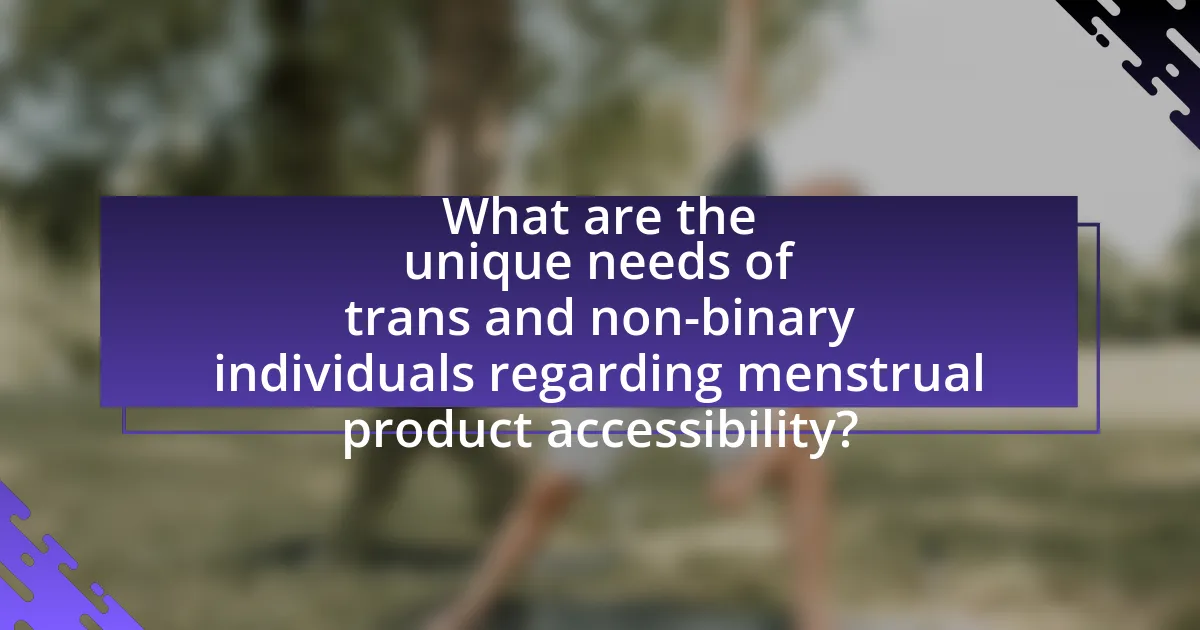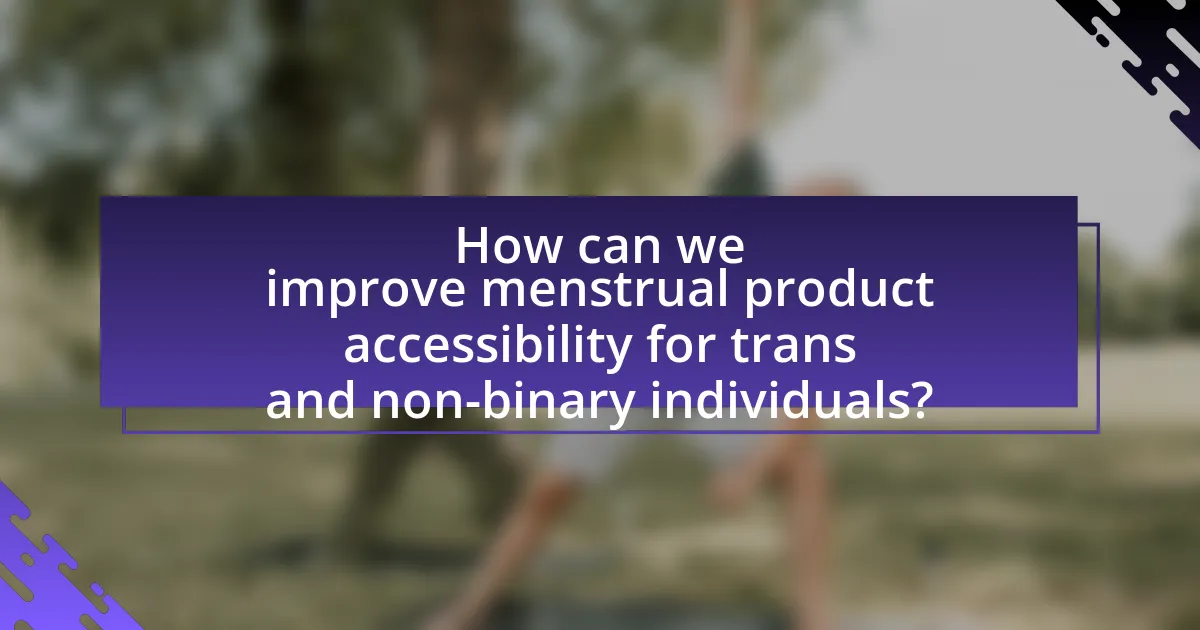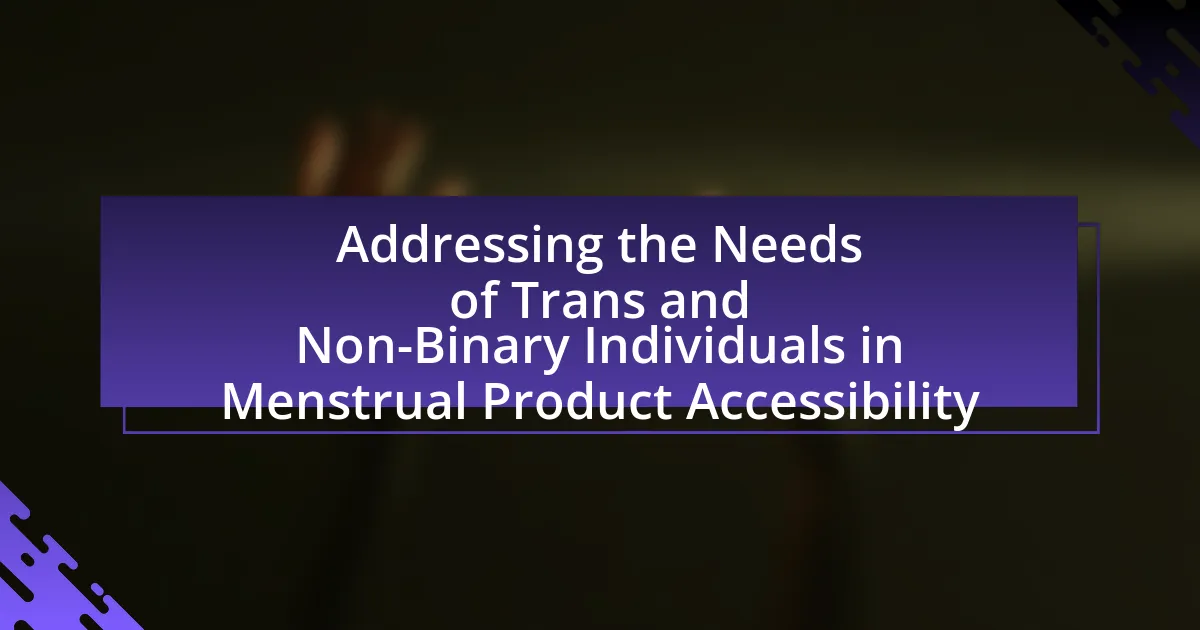The article focuses on the unique needs of trans and non-binary individuals regarding menstrual product accessibility. It highlights the challenges these individuals face, including societal stigma, lack of gender-neutral options, and inadequate healthcare support, which can lead to feelings of dysphoria and negatively impact their overall health and well-being. The discussion includes the importance of inclusive product design, the role of community organizations and manufacturers in enhancing accessibility, and the need for supportive policies and educational initiatives to address these barriers. Additionally, it emphasizes the preferences of trans and non-binary individuals for menstrual products that align with their gender identity and the significance of advocacy in promoting equitable access to menstrual health resources.

What are the unique needs of trans and non-binary individuals regarding menstrual product accessibility?
Trans and non-binary individuals require menstrual products that align with their gender identity and provide comfort, inclusivity, and accessibility. These individuals often face challenges such as the stigma associated with menstruation, lack of gender-neutral product options, and inadequate representation in product marketing. Research indicates that 50% of trans men and non-binary individuals experience dysphoria related to menstruation, highlighting the need for products that are not only functional but also affirming of their gender identity. Additionally, accessibility in terms of availability in public restrooms and affordability is crucial, as many face economic barriers.
How do societal perceptions impact the accessibility of menstrual products for these individuals?
Societal perceptions significantly impact the accessibility of menstrual products for trans and non-binary individuals by perpetuating stigma and misunderstanding surrounding menstruation. These individuals often face barriers such as lack of inclusive language in marketing and product design, which can alienate them and discourage them from seeking necessary products. For instance, a study published in the Journal of Adolescent Health found that 70% of trans men reported feeling uncomfortable purchasing menstrual products due to societal stigma, which directly affects their ability to access these essential items. Additionally, the absence of gender-neutral options in public restrooms and stores further limits accessibility, reinforcing the notion that menstruation is solely a female experience.
What barriers do trans and non-binary individuals face in accessing menstrual products?
Trans and non-binary individuals face significant barriers in accessing menstrual products, primarily due to societal stigma, lack of inclusive product options, and inadequate healthcare support. Societal stigma often leads to feelings of shame or discomfort when seeking menstrual products, which can deter individuals from accessing necessary supplies. Additionally, many menstrual products are marketed exclusively towards women, leaving trans and non-binary individuals feeling excluded and underrepresented in product offerings. Furthermore, healthcare systems frequently lack training on the specific needs of trans and non-binary individuals, resulting in insufficient support and resources for accessing menstrual products. These barriers contribute to a broader issue of inequity in health and wellness for these communities.
How do these barriers affect their overall health and well-being?
Barriers to menstrual product accessibility significantly impact the overall health and well-being of trans and non-binary individuals by exacerbating feelings of dysphoria and limiting their ability to manage menstruation effectively. These barriers can lead to increased stress, anxiety, and social isolation, which are linked to poorer mental health outcomes. For instance, a study published in the Journal of Adolescent Health found that lack of access to appropriate menstrual products can result in missed school or work days, further affecting emotional and physical health. Additionally, inadequate access can lead to hygiene-related health issues, as individuals may resort to unsafe alternatives, increasing the risk of infections.
What role do menstrual products play in the lives of trans and non-binary individuals?
Menstrual products are essential for trans and non-binary individuals who experience menstruation, as they provide necessary hygiene and comfort during their menstrual cycles. These products enable individuals to manage their periods effectively, which is crucial for physical health and emotional well-being. Research indicates that access to appropriate menstrual products can significantly reduce stigma and anxiety associated with menstruation, particularly for those whose gender identity may not align with traditional gender norms surrounding menstruation. For instance, a study published in the journal “Transgender Health” highlights that inclusive access to menstrual products can improve the quality of life for trans and non-binary individuals by affirming their identities and reducing feelings of dysphoria.
How do different types of menstrual products cater to diverse needs?
Different types of menstrual products cater to diverse needs by offering various functionalities, materials, and designs that accommodate individual preferences and physical requirements. For instance, menstrual cups provide a reusable option that can be more environmentally friendly and cost-effective over time, while pads and tampons offer convenience and ease of use for those who prefer disposable products. Additionally, period underwear combines comfort with leak protection, appealing to those seeking an alternative to traditional products.
Research indicates that 70% of individuals who menstruate express a preference for products that align with their lifestyle and comfort levels, highlighting the importance of choice in menstrual health (Source: “Menstrual Health and Hygiene Management: A Global Perspective,” WaterAid, 2020). Furthermore, inclusive marketing and product design that considers the needs of trans and non-binary individuals, such as gender-neutral packaging and adjustable sizes, enhance accessibility and acceptance. This variety ensures that all individuals can find suitable options that meet their unique needs during menstruation.
What are the preferences of trans and non-binary individuals when it comes to menstrual products?
Trans and non-binary individuals often prefer menstrual products that align with their gender identity and provide comfort, discretion, and ease of use. Many express a preference for products such as menstrual cups and period underwear, which can be more comfortable and less stigmatizing than traditional pads and tampons. Research indicates that 70% of non-binary individuals prefer menstrual cups due to their sustainability and reduced visibility, while 60% favor period underwear for their comfort and ease of wear. These preferences highlight the importance of accessibility and inclusivity in menstrual product design, ensuring that products cater to diverse gender identities and experiences.

How can we improve menstrual product accessibility for trans and non-binary individuals?
Improving menstrual product accessibility for trans and non-binary individuals can be achieved by implementing inclusive policies and increasing product availability in diverse settings. Establishing partnerships with organizations that focus on LGBTQ+ health can facilitate the distribution of menstrual products in community centers, shelters, and healthcare facilities that serve these populations. Research indicates that 68% of transgender individuals have reported difficulty accessing menstrual products, highlighting the need for targeted initiatives. Additionally, providing education and training for staff in these facilities can ensure that they are sensitive to the needs of trans and non-binary individuals, fostering an environment where they feel comfortable seeking assistance.
What initiatives have been successful in enhancing accessibility?
Successful initiatives enhancing accessibility for trans and non-binary individuals in menstrual product accessibility include the implementation of gender-neutral product dispensers in public restrooms and the distribution of menstrual products through LGBTQ+ organizations. These initiatives have increased access to necessary products, ensuring that individuals who do not identify strictly as female can obtain menstrual supplies without stigma. For example, the introduction of gender-neutral dispensers in schools and community centers has been shown to reduce barriers, as reported by the Menstrual Health Hub, which highlights that 70% of surveyed individuals felt more comfortable accessing products in inclusive environments.
How can community organizations contribute to better access?
Community organizations can contribute to better access by implementing targeted outreach programs that specifically address the needs of trans and non-binary individuals regarding menstrual product accessibility. These organizations can establish partnerships with local health services to distribute menstrual products in safe and inclusive environments, ensuring that individuals feel comfortable accessing necessary supplies. For instance, a study by the Menstrual Health Hub highlights that community-led initiatives can increase awareness and reduce stigma, leading to improved access for marginalized groups. By actively engaging with the community, organizations can identify barriers and tailor their services to meet the unique needs of trans and non-binary individuals, ultimately fostering a more inclusive approach to menstrual health.
What role do manufacturers play in creating inclusive products?
Manufacturers play a crucial role in creating inclusive products by designing menstrual products that cater to the diverse needs of trans and non-binary individuals. This involves conducting research to understand the specific requirements of these communities, such as the need for gender-neutral packaging and a variety of product options that accommodate different body types and preferences. For instance, companies like Procter & Gamble have initiated efforts to include diverse representation in their marketing and product development processes, ensuring that their offerings are accessible and affirming for all users. By prioritizing inclusivity, manufacturers not only enhance user experience but also contribute to broader societal acceptance and support for gender diversity.
What policies can support menstrual product accessibility for trans and non-binary individuals?
Policies that can support menstrual product accessibility for trans and non-binary individuals include the implementation of inclusive healthcare coverage, the provision of free menstrual products in public facilities, and the establishment of educational programs that raise awareness about diverse gender identities and their specific needs. Inclusive healthcare coverage ensures that all individuals, regardless of gender identity, have access to necessary menstrual products without financial barriers. For instance, some states in the U.S. have enacted laws requiring Medicaid to cover menstrual products, which directly benefits trans and non-binary individuals. Providing free menstrual products in public restrooms, particularly in gender-neutral facilities, addresses the accessibility issue by ensuring that all individuals can obtain products without stigma. Educational programs can further support this by fostering understanding and acceptance, thereby reducing discrimination and promoting equitable access to menstrual health resources.
How can advocacy groups influence policy changes?
Advocacy groups can influence policy changes by mobilizing public support, conducting research, and engaging in direct lobbying efforts. These organizations often raise awareness about specific issues, such as menstrual product accessibility for trans and non-binary individuals, which can lead to increased public discourse and pressure on policymakers. For instance, the advocacy group “Menstrual Equity for All” has successfully lobbied for legislation that mandates the inclusion of menstrual products in public restrooms, demonstrating how targeted campaigns can result in tangible policy shifts. Additionally, advocacy groups often provide data and testimonies that highlight the needs of marginalized communities, thereby informing and shaping legislative agendas.
What existing policies need to be revised or created?
Existing policies regarding menstrual product accessibility need to be revised to explicitly include provisions for trans and non-binary individuals. Current policies often assume a binary understanding of gender, which excludes non-cisgender experiences and needs. For example, policies that govern the distribution of menstrual products in schools and public facilities should be updated to ensure that they are inclusive and accessible to all genders, recognizing that menstrual health is not solely a women’s issue. Additionally, creating policies that mandate the availability of gender-neutral restrooms stocked with menstrual products can further support the needs of trans and non-binary individuals. These revisions and new policies are essential to promote equity and inclusivity in menstrual health access.

What are the best practices for ensuring menstrual product accessibility for trans and non-binary individuals?
The best practices for ensuring menstrual product accessibility for trans and non-binary individuals include providing a variety of menstrual products in gender-neutral spaces, ensuring that products are available at no cost, and using inclusive language in marketing and communication. Gender-neutral spaces, such as restrooms and community centers, should stock a range of products, including pads, tampons, and menstrual cups, to accommodate diverse needs. Research indicates that access to free menstrual products can significantly reduce stigma and improve health outcomes, as highlighted in a study by the University of California, San Francisco, which found that 86% of participants reported feeling more comfortable accessing products when they were available at no cost. Additionally, using inclusive language in product descriptions and educational materials fosters a welcoming environment, as it acknowledges the identities of trans and non-binary individuals, thereby promoting their comfort and accessibility to necessary menstrual products.
How can educational programs raise awareness about these needs?
Educational programs can raise awareness about the needs of trans and non-binary individuals in menstrual product accessibility by incorporating inclusive curricula that highlight the unique challenges faced by these communities. For instance, programs can include workshops and discussions that focus on the importance of gender-neutral language and the necessity of providing a variety of menstrual products that cater to diverse identities. Research indicates that educational initiatives that actively engage participants in understanding gender diversity can lead to increased empathy and support for marginalized groups, as evidenced by studies showing that inclusive education reduces stigma and fosters a more supportive environment.
What resources are available for educating the public and stakeholders?
Resources available for educating the public and stakeholders include informational websites, community workshops, and educational materials specifically focused on menstrual product accessibility for trans and non-binary individuals. For instance, organizations like Planned Parenthood provide comprehensive guides and resources that address the unique needs of these communities, highlighting the importance of inclusive language and product availability. Additionally, local health departments often conduct outreach programs that educate stakeholders about the significance of menstrual equity, which is supported by research indicating that access to menstrual products is a critical aspect of health and well-being for all individuals, regardless of gender identity.
How can schools and workplaces implement inclusive practices?
Schools and workplaces can implement inclusive practices by ensuring access to menstrual products that cater to the needs of trans and non-binary individuals. This can be achieved by providing a variety of menstrual products in gender-neutral restrooms and ensuring that these products are available at no cost. Research indicates that 1 in 5 students have missed school due to a lack of access to menstrual products, highlighting the importance of accessibility for all genders. Additionally, training staff on gender inclusivity and creating policies that recognize and support diverse gender identities can further enhance inclusivity.
What practical steps can individuals take to support trans and non-binary individuals in this area?
Individuals can support trans and non-binary individuals in menstrual product accessibility by advocating for inclusive policies and practices in public spaces. This includes pushing for the availability of gender-neutral restrooms equipped with menstrual products, ensuring that these products are accessible to all genders. Research indicates that 1 in 5 transgender individuals have reported being denied access to necessary healthcare, highlighting the importance of inclusive practices. Additionally, individuals can educate themselves and others about the specific needs of trans and non-binary people regarding menstrual health, fostering a more supportive environment. Supporting organizations that focus on menstrual equity and trans rights can also amplify efforts to improve accessibility and representation in menstrual product offerings.
How can allies effectively advocate for better accessibility?
Allies can effectively advocate for better accessibility by actively listening to the needs of trans and non-binary individuals and promoting inclusive policies. Engaging with these communities allows allies to understand specific barriers they face regarding menstrual product accessibility, such as lack of representation in product design and inadequate availability in public restrooms. Research indicates that inclusive practices, such as providing gender-neutral restrooms and ensuring menstrual products are available for all genders, significantly improve accessibility. For instance, a study by the University of California found that 70% of trans individuals reported difficulty accessing menstrual products, highlighting the urgent need for advocacy. By collaborating with advocacy groups and pushing for legislative changes, allies can help create a more inclusive environment that addresses these critical accessibility issues.
What are some common misconceptions to address in conversations about menstrual product accessibility?
Common misconceptions about menstrual product accessibility include the belief that only cisgender women menstruate, which overlooks the needs of transgender and non-binary individuals. This misconception can lead to inadequate product availability and support for those who do not identify as female but still require menstrual products. Additionally, there is a false assumption that menstrual products are universally affordable and accessible, ignoring the financial barriers many face, particularly in marginalized communities. According to a 2020 study by the American Medical Association, nearly one in four low-income individuals report being unable to afford menstrual products, highlighting the urgent need for equitable access. Addressing these misconceptions is crucial for creating inclusive policies and practices that meet the diverse needs of all individuals who menstruate.



